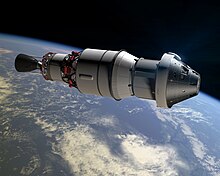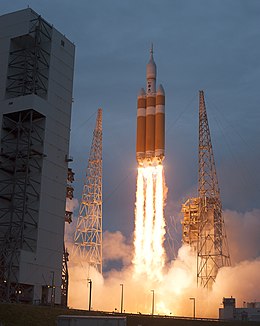|
Exploration Flight Test-1
Exploration Flight Test-1 or EFT-1 (previously known as Orion Flight Test 1 or OFT-1) was a technology demonstration mission and the first flight test of the crew module portion of the Orion spacecraft. Without a crew, it was launched on 5 December 2014 at 12:05 UTC (7:05 am EST, local time at the launch site) by a Delta IV Heavy rocket from Space Launch Complex 37B at the Cape Canaveral Air Force Station.[3] The mission was a four-hour, two-orbit test of the Orion crew module featuring a high apogee on the second orbit and concluding with a high-energy reentry at around 8.9 kilometers per second (20,000 mph).[4] This mission design corresponds to the Apollo 2/3 missions of 1966, which validated the Apollo flight control system and heat shield at re-entry conditions planned for the return from lunar missions. ObjectivesEFT-1 tested various systems of the crew module portion of the Orion spacecraft, including separation events, avionics, heat shielding, parachutes, and recovery operations prior to its flight aboard the Space Launch System rocket on the Artemis I mission. The Orion was not equipped with its companion European Service Module, using only a structural representation, and only had a partial launch abort system containing only the jettison motor. It was equipped with an Orion-to-stage adapter for testing.[5] The spacecraft remained attached to the dummy service module, which in turn remained attached to the Delta IV's upper stage (which is nearly identical to the Interim Cryogenic Upper Stage to be used on the Block 1 version of the Space Launch System rocket) until re-entry began and relied on internal batteries for power rather than photovoltaic arrays.[6] Data gathered from the test flight were analyzed by the critical design review (CDR) in April 2015.[7] Artemis I launched on 16 November 2022,[8] more than seven years after EFT-1. Vehicle assemblyOrion CM-001 used on the EFT-1 mission was built by Lockheed Martin.[9] On 22 June 2012, the final welds of the EFT-1 Orion were completed at the Michoud Assembly Facility in New Orleans, Louisiana.[9] It was then transported to Kennedy Space Center's Operations and Checkout Building, where the remainder of the spacecraft was completed.[10] The Delta IV rocket was put in a vertical position on 1 October 2014, and Orion was mated with the vehicle on 11 November.[11][12][13] Flight    The four-and-a-half-hour flight took the Orion spacecraft on two orbits of Earth. Peak altitude was approximately 5,800 kilometres (3,600 mi). The high altitude allowed the spacecraft to reach reentry speeds of up to 8.9 km/s (20,000 mph), which exposed the heat shield to temperatures up to around 2,200 °C (4,000 °F).[4][5]
After splashdown in the Pacific Ocean, crews from the USS Anchorage recovered the EFT-1 Orion crew vehicle. Plans were later made to outfit the capsule for an ascent abort test in 2017.[15] Launch attempts
Public outreachNASA heavily promoted the mission, collaborating with Sesame Street and its characters to educate children about the flight test and the Orion spacecraft.[16] The Orion capsule used for EFT-1 is now on display at the Kennedy Space Center Visitor Complex, in the "NASA Now" exhibit.[17] Gallery
References
External linksWikimedia Commons has media related to Exploration Flight Test-1. |
||||||||||||||||||||||||||||||||||||||||||||||||||||||||||||||||||||||||||||||||||||||||||||||||||||||||||||||||||||||||||||||||||||||||||||||||||||||||||||||||||














